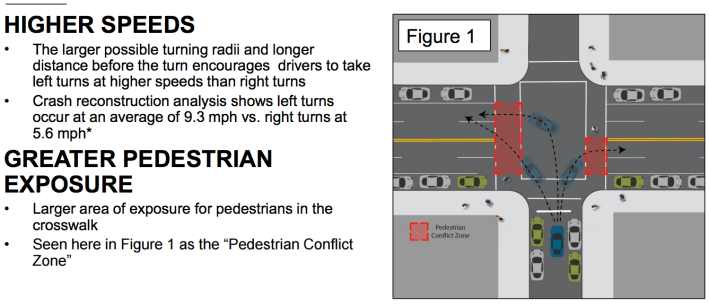
DOT will be ramping up the use of intersection treatments to protect pedestrians and cyclists from left-turning drivers, the agency announced today. The initiative is paired with a DOT study, "Don't Cut Corners" [PDF], that illustrates the disproportionate danger of left turns. Mayor de Blasio had announced in January that reducing the risk of left turns would be a focus of his administration's Vision Zero agenda this year.
Drivers turning left account for 19 percent of serious pedestrian and bicyclist injuries in New York City -- three times the share caused by right turns, according to the DOT report. Motorists tend to take left turns faster than right turns, a risk that is further compounded by the vehicle's "A-pillar" (between the windshield and the driver's door) obscuring the driver's vision, the pressure of both oncoming traffic and traffic behind the driver, and a greater area of exposure for pedestrians.
Based on crash reports, DOT found that injuries involving left turns typically occur when the driver turns from a minor street (usually one-way) onto a street 60 feet or wider (usually two-way).

The study also found that seniors are more likely to be injured or killed by left-turning vehicles: The average age of victims in left-turn crashes was 67, compared to 50 for victims of right-turn crashes.
DOT also studied the effectiveness of measures like leading pedestrian intervals, left turn restrictions, left turn bays, signals that fully separate turning drivers from crossing pedestrians and cyclists, and protected bike lanes. All of these treatments have led to a reduction in injuries involving left turns, according to before-and-after analysis of 478 intersections.

The de Blasio administration has rapidly expanded the use of leading pedestrian intervals (LPIs), which give pedestrians a head start to establish themselves in the crosswalk before turning motorists get a green light. In 2015, the city added 417 LPIs -- up from 55 in 2014 and 13 in 2013 -- and will install another 500 this year. DOT evaluated 104 intersections that received LPIs between 2003 and 2011 and found a 56 percent decline in pedestrian and bicyclist fatalities and severe injuries caused by left turns.
DOT Commissioner Polly Trottenberg unveiled the study this morning at the intersection of Lafayette Street and Kenmare Street in SoHo. On hand was Lucas Maxwell, a 9-year-old student at nearby P.S. 130 who made a video earlier this year urging DOT to make safety fixes at the location.
Since Maxwell posted the video, the intersection, which is in the top 1 percent of NYC intersections for left turn crashes, has received a number of fixes, including a "hardened centerline" on Kenmare and a 12-second head start for pedestrians crossing Lafayette, part of a "split LPI."
Split LPIs give pedestrians the signal before motor vehicles and then flash yellow for drivers instead of giving them a steady green -- a reminder to take the turn carefully. There are currently a few dozen split LPIs in the city. If they prove effective, DOT will accelerate the use of the treatment.

Hardened centerlines are another new safety treatment that will be piloted this summer at 100 of the city's most dangerous intersections for left turns. They consist of plastic posts on the centerline and prevent motorists from cutting corners. Another treatment that will be piloted this year, "enhanced daylighting," uses parking restrictions and painted curb extensions protected by plastic bollards to compel motorists to take more careful turns.





